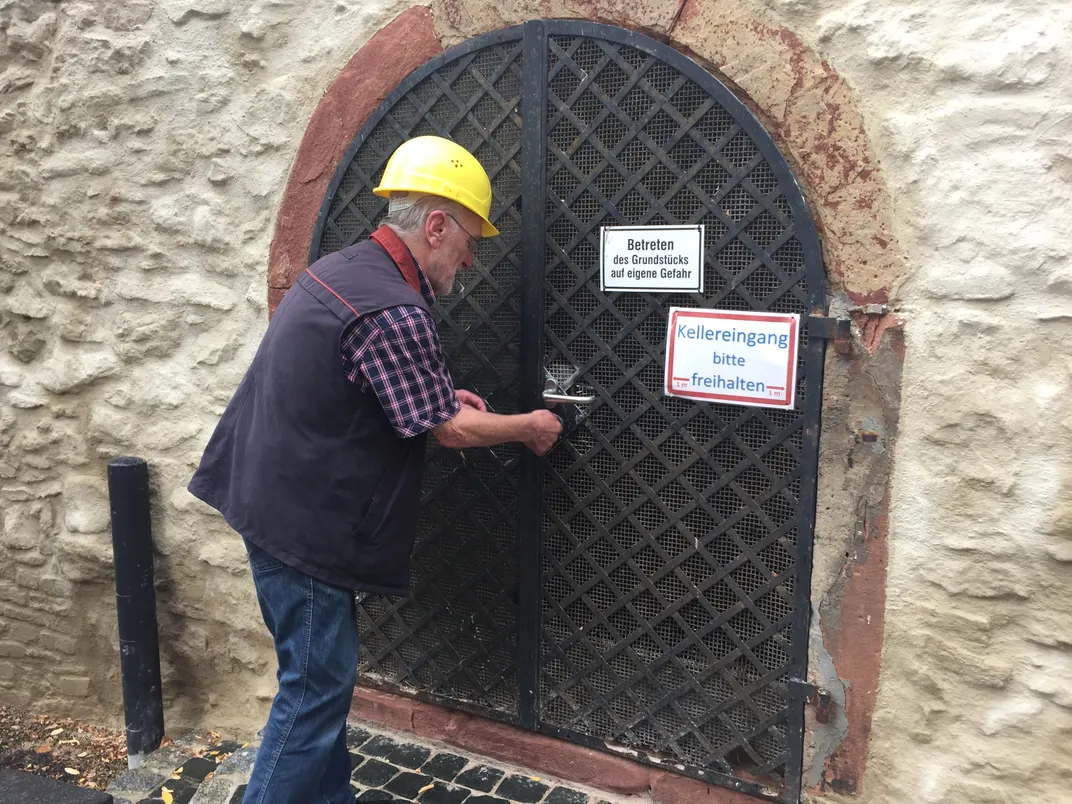Beneath This Medieval German Town Lie Over 25 Miles of Forgotten Tunnels
Go beneath the surface of Oppenheim
On the surface, Oppenheim looks like your typical German town resting along the banks of the Rhine River. But there's more to Oppenheim than beer halls and a Gothic-style cathedral from the Middle Ages. Beneath its narrow cobblestone streets lies something deeper—an entire labyrinth of tunnels and cellars.
“The town is practically honeycombed with cavities,” Wilfried Hilpke, a tour guide with Oppenheim’s tourism office, tells Smithsonian.com.
Hilpke should know. For the past ten years, he’s spent much of his time leading hour-long hardhat tours of Oppenheim’s elaborate tunnel system, taking visitors through a journey that covers just a fraction of the 25 miles of known tunnels residing beneath the surface. (It’s believed that there could be more than 124 miles of tunnels underneath the town, which is located 30 miles southwest of Frankfurt. However, many sections remain uncharted; they are thought to lead to private cellars beneath residents’ homes.)
Not only are the Kellerlabyrinth tunnels long in distance, but their history is equally deep. According to Hilpke, some of the oldest tunnels date back to 700 A.D. The tunnels got their start as food and wine storage cellars, and workers carved out the bulk of them using pickaxes and shovels during the 1600s, when residents were in need of extra storage space and channels to transport goods like wine. The tunnels took on a secondary purpose when the city's inhabitants used them to hide from Spanish troops during the Thirty Years' War. (They also used them to store Katharinenkirche cathedral’s stained glass windows to protect them during that war's bombardments.)
“Since the town was completely destroyed [during the 1689 War of Palatine Succession] by order of Louis XIV of France, it went under and never recovered as a commercial town,” Hilpke says. “No cellars were built after that time because they were not needed any longer.” Oppenheim was considered a free imperial city around this time, which allowed it to be self-ruled and have some autonomy, but also resulted in it being a target to outside forces.
After that tragic time, only a few hundred residents returned to Oppenheim to rebuild, filling the tunnels with dirt and debris during the reconstruction. Over the centuries the tunnels were largely forgotten, but in the 1980s a police car sunk into the roadway during a storm, revealing one of the hidden tunnels and jogging residents' memories. Although the topsoil that’s found throughout Oppenheim is predominately comprised of loess, a silt-like sediment that’s stable under normal conditions, it lost its stability due to moisture and lack of ventilation in the tunnels below, causing that section to cave in, which led to the almost miraculous discovery.
Beneath the loess sits limestone, “which you can practically dig using a tablespoon,” says Hilpke. He demonstrates by dragging his finger across one of the tunnel walls, causing a trail of dust. “It’s easy to dig, but also very solid. As long as it doesn’t get too moist, a herd of buffalo could walk over it.”
Over the years, people have unearthed artifacts that trace back to some of Oppenheim’s earliest inhabitants, such as utensils, shards of pottery and a rusted first aid kit, which are on display in a glass case as part of the tour. All told, the Kellerlabyrinth tour travels through five levels, all of which stay at a comfortable 60 to 66 degrees Fahrenheit year round, and include visits to a giant hall built in the 1940s that once served as a reservoir. Another room, called Rathaus-Keller (meaning "city hall basement"), has the telltale signs of once being a wine cellar due to blotches of black mold on the stone walls, the result of the aging process. Today, the room can be rented out for weddings and is often used as a practice room for choirs thanks to its optimal acoustics. And come Halloween, local residents transform it into a haunted house for kids.
Though interconnected cellars can be found in other wine-making regions, Oppenheim's miles of tunnels are something unique—one of Europe's most elaborate, and the only such system in Germany. “I wouldn’t be surprised if the tunnels are here 500 years from now,” Hilpke says. The real question is whether Oppenheim's residents will forget (and rediscover) them again over the centuries.

/https://tf-cmsv2-smithsonianmag-media.s3.amazonaws.com/filer/94/3b/943b0f6f-c1a7-4282-9d2d-7b2165e4cbf5/img_2979.jpg)
/https://tf-cmsv2-smithsonianmag-media.s3.amazonaws.com/filer/72/8a/728a52d8-6bc6-4e27-92a7-554e2e98434b/img_2980.jpg)
/https://tf-cmsv2-smithsonianmag-media.s3.amazonaws.com/filer/ce/6e/ce6e399b-1093-4596-9cf0-4a449bc9da07/img_2981.jpg)
/https://tf-cmsv2-smithsonianmag-media.s3.amazonaws.com/filer/a8/bf/a8bfa1ef-113a-42ca-b612-a660a2db6d2c/img_2989.jpg)
/https://tf-cmsv2-smithsonianmag-media.s3.amazonaws.com/filer/bf/e4/bfe473b9-3e87-4cb0-8f15-2e49eadcbb1f/img_3025.jpg)
/https://tf-cmsv2-smithsonianmag-media.s3.amazonaws.com/filer/5a/d0/5ad082f5-5c5f-47e4-8941-7292974607a3/img_3051.jpg)
/https://tf-cmsv2-smithsonianmag-media.s3.amazonaws.com/filer/d8/f3/d8f311af-5359-41b7-a463-b2cd3f22857e/img_3075.jpg)
/https://tf-cmsv2-smithsonianmag-media.s3.amazonaws.com/filer/94/9e/949e34d0-7801-4891-bebf-d058ce680f68/img_3084.jpg)
/https://tf-cmsv2-smithsonianmag-media.s3.amazonaws.com/filer/e7/0c/e70cfe17-899d-4f02-8c98-81fd3681ff91/img_3086.jpg)